Continuing Low Interest Rates Environment for Long term U.S. Treasury Bonds
Interest-Rates / US Bonds Jan 29, 2014 - 04:47 PM GMTBy: John_Mauldin
 Last week Greg Weldon made the case for rising interest rates on US treasuries. This week Lacy Hunt offers us the case for a continued low-interest-rate environment for long-term treasuries. This is one of the most fascinating tugs-of-war in the investment world today. I’ve made the argument that we are in a deflationary deleveraging world for quite some time to come, or at least until the velocity of money turns around. Lacy makes that point, too, and offers some insights into the velocity of money. This is a fascinating Outside the Box, and I won’t spoil it by stealing any more of Lacy’s thunder.
Last week Greg Weldon made the case for rising interest rates on US treasuries. This week Lacy Hunt offers us the case for a continued low-interest-rate environment for long-term treasuries. This is one of the most fascinating tugs-of-war in the investment world today. I’ve made the argument that we are in a deflationary deleveraging world for quite some time to come, or at least until the velocity of money turns around. Lacy makes that point, too, and offers some insights into the velocity of money. This is a fascinating Outside the Box, and I won’t spoil it by stealing any more of Lacy’s thunder.
I write from a sunny, if cold, Dallas. The thermostat has been a topic of conversation in my apartment lately, and not just because we need to keep turning it up. By now, the entire world knows that Google bought the thermostat company Nest for $3.2 billion, a good 50% more than the valuation Nest was trying to raise money on just a month earlier. I was rather surprised at the price, but I was also surprised that Google paid $1.65 billion for YouTube. Now, six years later, the YouTube franchise produced almost $6 billion in revenues last year. Clearly, the founders of Google saw something that much of the world did not see at the time. My suspicion is that Nest will end up ranking in the same category of return on investment for Google.
I have installed the cool new Nest thermostats in my new apartment. Having bought and installed thermostats on my own for various homes in the past, I was thoroughly surprised at the value of the Nest thermostat. Just a few years ago it would’ve cost some three to four times more to buy the same functionality that the Nest thermostat has. And this little toy does so much more. It actually adjusts itself to my personal habits and preferences and allows me to change everything from my iPad when I go to bed in the evening or get up in the morning, with a thoroughly programmable slate of settings. It even senses when I come close to it. It is just one element in what will soon be the Internet of Things that Cisco CEO John Chambers says will rapidly come to be worth $20 trillion.
I’m enjoying all the new technology that we’ve installed in the apartment, and we’ve designed and wired it to be able to adapt to what we think will be the direction of further change. I’m just hoping I don’t have to buy antivirus software for my oven.
Have a great week.
Your thinking about mortgage interest rates analyst,
John Mauldin, Editor
Outside the Boxsubscribers@mauldineconomics.com
Hoisington Investment Management – Quarterly Review and Outlook - Fourth Quarter 2013
In The Theory of Interest, Irving Fisher, who Nobel Laureate Milton Friedman called America's greatest economist, created the Fisher equation, which states the nominal bond yield is equal to the real yield plus expected inflation. It serves as the pillar of macroeconomics and as the foundational relationship of the bond market. It has been reconfirmed many times by scholarly examination and by the sheer force of historical experience. Examining periods of both low and high inflation offers insight into how each variable in the Fisher equation affects the outcome.
From 1871 to 1948, a period of relatively low inflation, the Treasury bond yield averaged 2.9%, with the inflation rate 1.0% and the real yield 1.9%. From 1948 to 1989, a period of higher inflation, the Treasury bond yield increased to 6.0%, inflation jumped to 4.3% on average, but the real yield remained close to historical levels at 1.7% (Chart 1). In more recent times, the inflation rate has changed, but the real rate has remained close to historical averages. The significant point is that while average inflation and bond yields were volatile, the average real yield was far more stable. Over these longer stretches the average real yield was never far from the post 1871 average of 2.2%. Thus, over long periods of time, bond yields fluctuated in response to rising and falling inflation. However, the real bond yield steadily reverted to its mean indicating that inflation was the driving force in determining the bond yield over time.
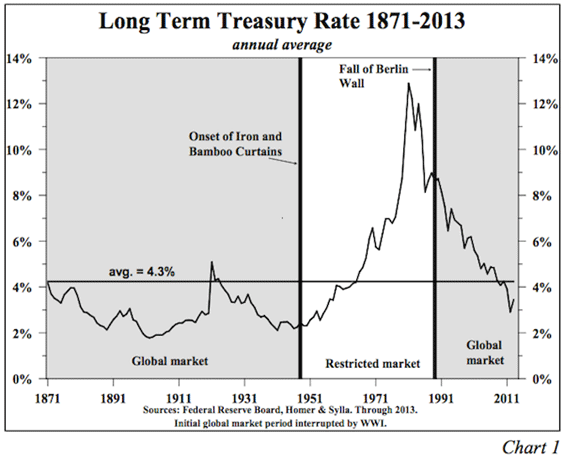
Inflation
A host of different factors caused inflation to vary in the aforementioned periods, but two points of significance are identifiable. First, the seventy-year plus span between 1871 and 1948 (excluding the World War years) was an extended global market era. It began about the time of uninterrupted transcontinental railroad travel and the completion of the Suez Canal and resulted in a period of rapidly expanding global trade. By 1871, 10% of U.S. railroad traffic carried goods that were traded globally. This era produced increasing returns to scale and minimized price pressures. Second, the 1871-1948 period encompassed two episodes of high indebtedness: the 1870s and then the 1920s until the mid-to-late 1940s. Both severely destabilized economic activity and produced minimal inflation, which in turn led to bond yields that eventually reached slightly less than 2%.
From 1871 to 1948, there were two, twenty-year periods when the total return on long- term Treasury bonds exceeded the total return on the S&P 500: one from the 1870s to the 1890s and another from 1928 to 1948. Additionally, the traditional vibrancy in demographic trends in the United States ended during the 1930s as both the birth rate and total increase in population slowed dramatically.
The period from 1948 to 1989 differs markedly. By 1948, a global market did not exist, and the excessive indebtedness of the 1920-1930s had been eliminated. In the late 1940s, the Iron and Bamboo Curtains imposed by Russia and China removed roughly 50% of the world's population from global trade, reducing economies of scale. During the war years, from 1933 to 1948, the U.S. ratio of public and private debt to GDP dropped from 295% to 139%, as the personal saving rate jumped from below zero to 28% (Chart 2). With normal and sustainable debt levels the U.S. entered the post-war boom, a period of rapidly rising prosperity that produced greater returns in the S&P 500 than on long-term Treasury bonds. Additionally, the abysmal demographics of the 1930s gave way to the post-war baby boom as households became more positive about their economic prospects.
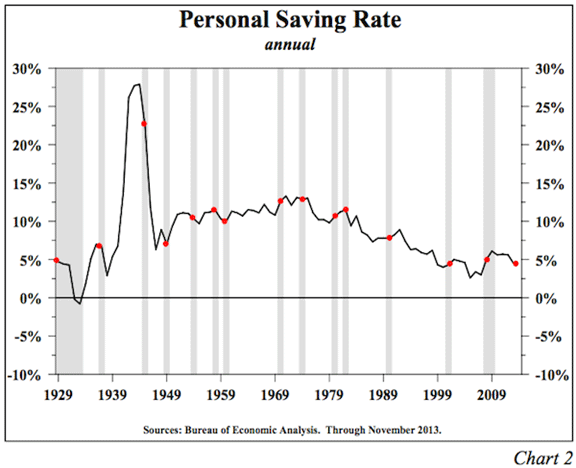
Today, conditions resemble the 1871-1948 period. Global trade is once again less inhibited and public and private debt is high and rising. The saving rate is also greatly depressed. In this modern era of high indebtedness, there have been long periods of negative risk premium which have lasted over a decade. Demographics have also soured. The birth rate in 2013 fell to the lowest level on record, and the population increase was the slowest since the depression era year of 1937. Thus, fundamental conditions are now conducive for an inflation rate averaging 1% or less. Based on the Fisher equation, long-term bond yields should be comfortable trading at 3% or lower.
The global inflation rate is influenced by many factors, but the current bout of low inflation and the insufficiency of demand are both symptoms of extreme over-indebtedness. Weakness in prices is evident in various price indices. Over the twelve months ending in November, the price of goods in the CPI actually decreased 0.5%, while the more accurately measured durable and nondurable components of the U.S. personal consumption deflator fell by 2.0% and 0.6%, respectively. Prices of imported goods fell 1.5% over the same period; excluding oil the decline was nearly as large. Facing weak domestic demand, foreign producers cut prices on goods headed toward the U.S. market, and this forced domestic producers to match those lower prices.
A lack of pricing power is likely to continue in 2014. First, the global economy continues to incur more indebtedness. Both public and private debt in the major economies of the world continue to move further above the levels that create a sustained negative impact on economic activity. Second, monetary conditions moved in the wrong direction last year, partially as a result of misguided policy efforts at quantitative manipulation of reserves. Third, although the sequester of government expenditures will be less in 2014 than in 2013, fiscal policy in the broadest sense is not supportive of economic growth.
Indebtedness
Academic research has shown that a public and private debt to GDP ratio above the range of 260-275% has a depressing impact on economic growth. In 2000 the U.S. debt level exceeded this range. Since then, the bond yield has averaged 4.6%, with inflation 2.1% and the real yield 2.5%. By comparing growth and debt figures prior to 2000 with those afterward, the magnitude of the problem and likelihood of its persistence can be assessed. From 1871 to 1999, private and public debt averaged less than 165% of GDP (well below the 260-275% critical level), and the trend growth in real GDP was 3.8%. From 2000 through 2013, growth has faltered to just 1.9%. Based on the latest 2013 figures, total private and public debt amounted to $58.2 trillion or 344% of GDP (Chart 3). If the debt to GDP ratio were currently the same as the average from 1871 to 1999, total debt should only amount to $30.5 trillion, or almost half of the existing level. The debt to GDP ratio declined since peaking in 2009 but not sufficiently to re-enter the normal range. Moreover, the ratio resumed its upward trend in 2013. Thus, the U.S. appears to be following the Japanese example of trying to cure an indebtedness problem by accumulating more debt.
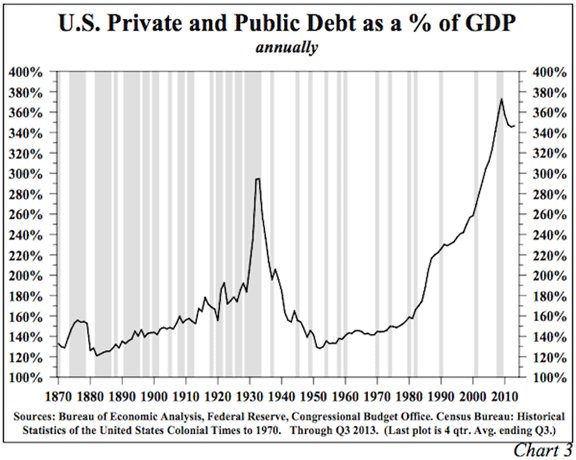
Scholarly research conducted in the U.S. and Europe over the past three years indicates that existing levels of government debt relative to GDP have reached the point that historically have produced a deleterious effect on economic growth. In the past this effect has lasted two decades or longer. As termed by European researchers, the current levels have reached the "non-linear zone". This means that the negative effects on growth are likely to intensify as this debt ratio moves higher. Ignoring this research is ill advised, especially since the debt levels are advancing. Although the U.S. budget deficit was smaller last year, the more critical debt ratio continued to rise.
According to the Organization for Economic Cooperation and Development (OECD), General U.S. Government Gross Financial Liabilities as a percent of GDP reached 104.1% in 2013, the highest level since the early 1950s (Table 1). (Gross, rather than net, government debt is the appropriate measure; netting out the government debt held in other government accounts is not appropriate since the social insurance trusts have far greater liabilities than they have government securities to fund those future commitments.) By the end of 2015 the OECD projects this figure to jump to 106.5%. Over the next twenty-five years the Congressional Budget Office projects government debt to GDP to move dramatically higher.
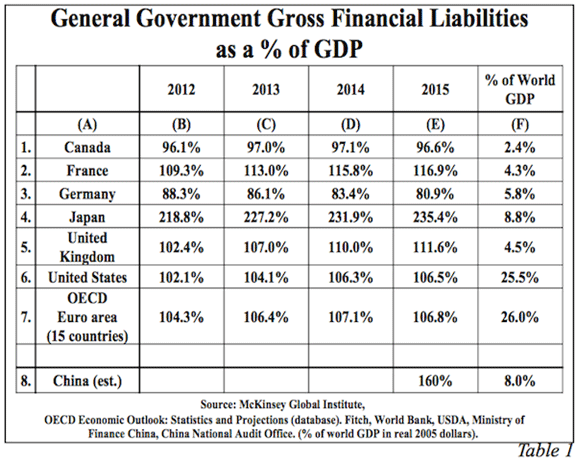
Since European fiscal policies mirror those in the U.S., it is not surprising that growth prospects there remain dismal. According to the OECD, General Government Gross Financial Liabilities in the Euro area reached 106.4% of GDP in 2013, up from 95.6% in 2011, an even faster rise than in the United States (Table 1). New research shows that the world average of total public debt, expressed as a percent of global GDP, is approximating its highest level since 1826 (IMF Working Paper WP/13/266, "Financial and Sovereign Debt Crises: Some Lessons Learned and Those Forgotten", December 2013, by Carmen M. Reinhart and Kenneth S. Rogoff). Private debt to GDP in the Euro currency zone and the UK (and interestingly, in Japan) are all higher than in the U.S. and even further above the levels that research has identified as being detrimental to growth.
Monetary Conditions
As discussed in our last quarterly letter, three academic papers presented at the Jackson Hole conference determined that the present approach of quantitative easing by the Federal Reserve has actually slowed economic activity. Three considerations - real interest rates, the money multiplier and the velocity of money - indicate that monetary policy is working against economic growth.
First, monetary policy works primarily through price effects. The level of real interest rates determines the price of credit. In 2013, long-term Treasury bond yields rose 100 basis points, or 1.0%. The inflation rate, measured by the year-over-year change in the Fed's targeted core personal consumption expenditure deflator, dropped 50 basis points. This pushed the real yield on the thirty-year bond to nearly 3% at the close of 2013. Thus, real yields currently carry a significant premium to the long-term average. The effects of this rising price of credit are visible in the high frequency housing data. Pending and existing home sales in November were below year ago levels. Mortgage applications for home purchases in December were at their lowest level in more than a decade.
Second, the money multiplier, which reflects the conversion of bank reserves into deposits (money) by the banking system, fell to a new 100 year low of less than 3 in late December 2013. This is an indication that the Fed's Large Scale Asset Purchases (LSAP) are not currently producing real, tangible economic effects and are not likely to in the future. Since 1913, $1 of high-powered money has, on average, resulted in an increase of $8.20 of M2 (Chart 4). The current multiplier constitutes an unprecedented historical gap. To begin the process of accelerating economic growth from a monetary perspective, an increase in the multiplier would be necessary. The best indicator of whether this process is working would be the expansion of bank credit, which includes bank investments and bank loans. Unfortunately, the expansion of total bank credit is only 2.0% higher than a year ago, and bank loans have expanded by only 1.9%. In spite of the Fed's massive LSAP, M2 expanded at a slightly slower pace in the latest twelve months than it did in 2012.
Third, the even more important velocity of money (V) rejects the argument that monetary policies are gaining traction. Velocity, or the speed at which money turns over, links M2 to the level of nominal economic activity. With the money supply expanding at 5.6% in the latest year, it would be reasonable to expect the same growth rate in nominal GDP if V were stable. Unfortunately, since 1997 velocity has been falling, and in the last twelve months it has dropped by 3% to 1.57, the lowest level in six decades (Chart 4). While velocity is influenced by a myriad of factors, the rate of change of financial innovation and lending for productive purposes affect its direction. If debt generates an income stream that repays principal and interest and creates other activities, it will tend to expand economic activity and cause V to rise. Student, auto and other loans for consumption (which represent the bulk of the increase in consumer credit in 2013) do not meet the necessary criteria, so debt is merely an acceleration of future consumption. This will tend to inhibit the borrower's ability to increase consumption in the future. Further, new regulations on our financial industries are discouraging financial innovation, and this will bring further downward pressure on velocity. In 2014, if velocity continues to erode at a 3% pace and money supply continues to grow around 6%, it is reasonable to anticipate that nominal GDP will expand at about a 3% growth rate.
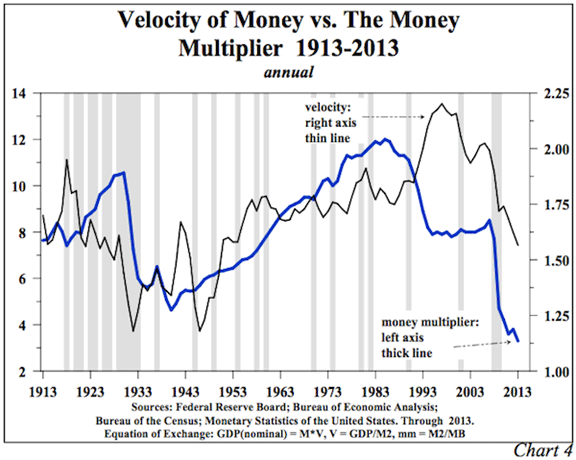
Fiscal Issues
Based on scholarly research, only half of the negative economic impact emanating from the $275 billion 2013 tax increase has been registered. Due to the recognition and implementation lags, the remaining drag on growth from the tax increase will occur this year and again in 2015. Carrying a negative multiplier of 2 to 3, this impact far outweighs the sequester (which is expected to be slightly less in 2014 than in 2013) since the multiplier for government expenditures is zero, if not slightly negative.
An important fiscal policy event for 2014 is the Affordable Care Act (ACA). Healthcare is the largest U.S. industry, comprising 17.2% of the economy in 2012. This is more than twice as large as residential construction, oil and gas exploration and the automotive sectors combined. The scope and scale of ACA may divert energy and activity away from more productive endeavors. The ACA's employer mandate was waived in 2013, as were similar obligations of labor unions and others, but these waivers expire this year. Firms may have to cut some full time employees to part time, reduce total employment or cut benefits since they lack pricing power to cover these costs. As such, this will place the burden of adjustment on consumers. On January 1, health insurance premiums that target small businesses and individuals were raised. These groups create jobs and are vital for growth, thus even though the amount of the increase is small, this is still a net drag for economic growth. While the ACA is an unprecedented event for which no historical point of comparison exists, history does confirm that substantial increases in government regulation are not a springboard for innovation, the lifeblood of economic activity.
The slow nominal growth rate anticipated for 2014 should continue to put downward pressure on the inflation rate as the insufficiency of demand continues to create highly competitive markets. With slower inflation, lower long-term interest rates are a probable outcome.
Van R. Hoisington
Lacy H. Hunt, Ph.D.
Like Outside the Box?
Sign up today and get each new issue delivered free to your inbox.
It's your opportunity to get the news John Mauldin thinks matters most to your finances.
© 2013 Mauldin Economics. All Rights Reserved.
Outside the Box is a free weekly economic e-letter by best-selling author and renowned financial expert, John Mauldin. You can learn more and get your free subscription by visiting www.MauldinEconomics.com.
Please write to subscribers@mauldineconomics.com to inform us of any reproductions, including when and where copy will be reproduced. You must keep the letter intact, from introduction to disclaimers. If you would like to quote brief portions only, please reference www.MauldinEconomics.com.
To subscribe to John Mauldin's e-letter, please click here: http://www.mauldineconomics.com/subscribe
To change your email address, please click here: http://www.mauldineconomics.com/change-address
Outside the Box and MauldinEconomics.com is not an offering for any investment. It represents only the opinions of John Mauldin and those that he interviews. Any views expressed are provided for information purposes only and should not be construed in any way as an offer, an endorsement, or inducement to invest and is not in any way a testimony of, or associated with, Mauldin's other firms. John Mauldin is the Chairman of Mauldin Economics, LLC. He also is the President of Millennium Wave Advisors, LLC (MWA) which is an investment advisory firm registered with multiple states, President and registered representative of Millennium Wave Securities, LLC, (MWS) member FINRA, SIPC, through which securities may be offered . MWS is also a Commodity Pool Operator (CPO) and a Commodity Trading Advisor (CTA) registered with the CFTC, as well as an Introducing Broker (IB) and NFA Member. Millennium Wave Investments is a dba of MWA LLC and MWS LLC. This message may contain information that is confidential or privileged and is intended only for the individual or entity named above and does not constitute an offer for or advice about any alternative investment product. Such advice can only be made when accompanied by a prospectus or similar offering document. Past performance is not indicative of future performance. Please make sure to review important disclosures at the end of each article. Mauldin companies may have a marketing relationship with products and services mentioned in this letter for a fee.
Note: Joining The Mauldin Circle is not an offering for any investment. It represents only the opinions of John Mauldin and Millennium Wave Investments. It is intended solely for investors who have registered with Millennium Wave Investments and its partners at http://www.MauldinCircle.com (formerly AccreditedInvestor.ws) or directly related websites. The Mauldin Circle may send out material that is provided on a confidential basis, and subscribers to the Mauldin Circle are not to send this letter to anyone other than their professional investment counselors. Investors should discuss any investment with their personal investment counsel. You are advised to discuss with your financial advisers your investment options and whether any investment is suitable for your specific needs prior to making any investments. John Mauldin is the President of Millennium Wave Advisors, LLC (MWA), which is an investment advisory firm registered with multiple states. John Mauldin is a registered representative of Millennium Wave Securities, LLC, (MWS), an FINRA registered broker-dealer. MWS is also a Commodity Pool Operator (CPO) and a Commodity Trading Advisor (CTA) registered with the CFTC, as well as an Introducing Broker (IB). Millennium Wave Investments is a dba of MWA LLC and MWS LLC. Millennium Wave Investments cooperates in the consulting on and marketing of private and non-private investment offerings with other independent firms such as Altegris Investments; Capital Management Group; Absolute Return Partners, LLP; Fynn Capital; Nicola Wealth Management; and Plexus Asset Management. Investment offerings recommended by Mauldin may pay a portion of their fees to these independent firms, who will share 1/3 of those fees with MWS and thus with Mauldin. Any views expressed herein are provided for information purposes only and should not be construed in any way as an offer, an endorsement, or inducement to invest with any CTA, fund, or program mentioned here or elsewhere. Before seeking any advisor's services or making an investment in a fund, investors must read and examine thoroughly the respective disclosure document or offering memorandum. Since these firms and Mauldin receive fees from the funds they recommend/market, they only recommend/market products with which they have been able to negotiate fee arrangements.
PAST RESULTS ARE NOT INDICATIVE OF FUTURE RESULTS. THERE IS RISK OF LOSS AS WELL AS THE OPPORTUNITY FOR GAIN WHEN INVESTING IN MANAGED FUNDS. WHEN CONSIDERING ALTERNATIVE INVESTMENTS, INCLUDING HEDGE FUNDS, YOU SHOULD CONSIDER VARIOUS RISKS INCLUDING THE FACT THAT SOME PRODUCTS: OFTEN ENGAGE IN LEVERAGING AND OTHER SPECULATIVE INVESTMENT PRACTICES THAT MAY INCREASE THE RISK OF INVESTMENT LOSS, CAN BE ILLIQUID, ARE NOT REQUIRED TO PROVIDE PERIODIC PRICING OR VALUATION INFORMATION TO INVESTORS, MAY INVOLVE COMPLEX TAX STRUCTURES AND DELAYS IN DISTRIBUTING IMPORTANT TAX INFORMATION, ARE NOT SUBJECT TO THE SAME REGULATORY REQUIREMENTS AS MUTUAL FUNDS, OFTEN CHARGE HIGH FEES, AND IN MANY CASES THE UNDERLYING INVESTMENTS ARE NOT TRANSPARENT AND ARE KNOWN ONLY TO THE INVESTMENT MANAGER. Alternative investment performance can be volatile. An investor could lose all or a substantial amount of his or her investment. Often, alternative investment fund and account managers have total trading authority over their funds or accounts; the use of a single advisor applying generally similar trading programs could mean lack of diversification and, consequently, higher risk. There is often no secondary market for an investor’s interest in alternative investments, and none is expected to develop.
John Mauldin Archive |
© 2005-2022 http://www.MarketOracle.co.uk - The Market Oracle is a FREE Daily Financial Markets Analysis & Forecasting online publication.



